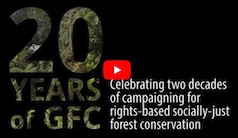Victory for Developing countries over Northern business interests
The conference, which was baptized as a ‘re-birth of environmental multilateralism [2] after the failed climate talks in Copenhagen, also adopted a strategic plan with concrete targets to reduce biodiversity loss, restore 15% of the world’s degraded areas and significantly increase the financial contribution of donor countries to biodiversity conservation.
Negotiations were stalled for most of last week when it was clear Canada and the EU did not want to agree on a strong and legally binding protocol and strong commitments to provide financial resources to conserve biodiversity.
The conference was marked by a significant divide between developing countries and industrialized counties over market-based and other pro-business approaches to biodiversity. While the EU and other Northern countries pushed for market-based mechanisms, including as a financial resource for biodiversity conservation, many Southern countries pointed at the serious environmental and social risks of these mechanisms, and proposed strong policies and measures instead.
As a result of this opposition, references to risky innovative financial mechanisms like the Green Development Mechanism were removed from the final outcomes of the conference.
Southern countries also expressed strong concern about the potential impact of climate change mitigation measures like monoculture tree plantations, REDD [3] and bio-energy on biodiversity and the rights and needs of Indigenous Peoples and local communities. As a result, the conference adopted a world-wide moratorium on geo-engineering [4], including large-scale biochar and other forms of large-scale carbon sequestration by tree plantations.
The Conference calls upon countries to prevent negative impacts of other climate changes mitigation measures like bio-energy and REDD , on biodiversity and people. The meeting also urges governments to be precautious with the use of the synthetic biology, or invasive alien species like eucalypt, for bio-energy production.
“It is clear that Southern countries are increasingly concerned about the commodification of nature through market-based approaches like carbon markets and the potential impacts of these markets on Indigenous Peoples, local communities and women” says Simone Lovera, Executive Director of the Global Forest Coalition.
“We are happy that, in the end, the EU and other Northern countries realized that the survival of our planet’s biodiversity is of fundamental importance for the survival of mankind and thus needed to be prioritized over the interests of pharmaceutical companies and carbon traders”. ###
For more information:
Janneke Romijn, Media Coordinator, Global Forest Coalition, 31 6 82.07.13.82, janneke.romijn@globalforestcoalition.org
Simone Lovera, Executive Director, Global Forest Coalition, 595.981.407375, simone.lovera@globalforestcoalition.org
Notes:
[1] The Global Forest Coalition is a worldwide coalition of NGOs and Indigenous Peoples’ Organizations promoting rights-based socially just and effective forest conservation policies. www.globalforestcoalition.org
[2] http://www.iisd.ca/biodiv/cop10/compilatione.pdf
[3] REDD is the word used for policies and incentives to reduce emissions of deforestation and forest degradation and enhance carbon stocks.
[4] The text that was adopted by the Parties in the working group reads: Under Climate Change and Biodiversity (UNEP/CBD/COP/10/L.36)8. Invites Parties and other Governments, according to national circumstance and priorities, as well as relevant organizations and processes, to consider the guidance below on ways to conserve, sustainably use and restore biodiversity and ecosystem services while contributing to climate change mitigation and adaptation:
….
(w) Ensure, in line and consistent with decision IX/16 C, on ocean fertilization and biodiversity and climate change, in the absence of science based, global, transparent and effective control and regulatory mechanisms for geo-engineering, and in accordance with the precautionary approach and Article 14 of the Convention, that no climate-related geo-engineering activities[1] that may affect biodiversity take place, until there is an adequate scientific basis on which to justify such activities and appropriate consideration of the associated risks for the environment and biodiversity and associated social, economic and cultural impacts, with the exception of small scale scientific research studies that would be conducted in a controlled setting in accordance with Article 3 of the Convention, and only if they are justified by the need to gather specific scientific data and are subject to a thorough prior assessment of the potential impacts on the environment;
[1] Without prejudice to future deliberations on the definition of geo-engineering activities, understanding that any technologies that deliberately reduce solar insolation or increase carbon sequestration from the atmosphere on a large scale that may affect biodiversity (excluding carbon capture and storage from fossil fuels when it captures carbon dioxide before it is released into the atmosphere) should be considered as forms of geo-engineering which are relevant to the Convention on Biological Diversity until a more precise definition can be developed. Noting that solar insolation is defined as a measure of solar radiation energy received on a given surface area in a given hour and that carbon sequestration is defined as the process of increasing the carbon content of a reservoir/pool other than the atmosphere. — – — – —










